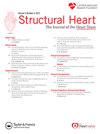Mitral Annular Calcification: Understanding the Disease and Treatment Options
IF 2.8
Q3 CARDIAC & CARDIOVASCULAR SYSTEMS
引用次数: 0
Abstract
Mitral annular calcification (MAC) is a degenerative process that causes calcium deposits along the mitral annulus. The pathophysiological mechanisms contributing to the development of MAC are not fully understood. The main risk factors for MAC are advanced age, female gender, chronic kidney disease, and conditions predisposing to left ventricular hypertrophy, which increases mitral annulus tension and subsequent annular degeneration. The prevalence of MAC varies widely among studies, from 5% to 42%, depending on the characteristics of the study population and the imaging modality used to make the diagnosis, and it is increasing over time. MAC is independently associated with all-cause mortality, cardiovascular mortality, and the occurrence of cardiovascular disease such as atrial fibrillation, conduction abnormalities, or stroke. MAC can progress and involve the mitral valve leaflets, causing mitral stenosis, mitral regurgitation, or both. Patients who develop symptomatic mitral valve dysfunction associated with significant MAC have lower survival when mitral valve intervention is not performed. However, the surgical risk of these patients is often high, precluding surgery in many. Therefore, transcatheter mitral valve implantation is emerging as an alternative in patients with severe MAC and associated symptomatic mitral valve dysfunction. This manuscript summarizes a description of the disease process in MAC and its treatment options.
二尖瓣环钙化:了解疾病和治疗方案
二尖瓣环钙化(MAC)是一种变性过程,导致钙沉积沿二尖瓣环。促进MAC发展的病理生理机制尚不完全清楚。MAC的主要危险因素是高龄、女性、慢性肾脏疾病和左心室肥厚的易感性,后者会增加二尖瓣环的张力和随后的二尖瓣环变性。在不同的研究中,MAC的患病率差异很大,从5%到42%不等,这取决于研究人群的特征和用于诊断的成像方式,并且随着时间的推移,它正在增加。MAC与全因死亡率、心血管死亡率和心血管疾病(如心房颤动、传导异常或中风)的发生独立相关。MAC可进展并累及二尖瓣小叶,引起二尖瓣狭窄、二尖瓣返流或两者兼而有之。如果不进行二尖瓣干预,伴有显著MAC的症状性二尖瓣功能障碍的患者生存率较低。然而,这些患者的手术风险往往很高,许多人无法进行手术。因此,经导管二尖瓣植入术正在成为严重MAC和相关症状性二尖瓣功能障碍患者的一种替代方法。本文概述了MAC的发病过程及其治疗方案。
本文章由计算机程序翻译,如有差异,请以英文原文为准。
求助全文
约1分钟内获得全文
求助全文
来源期刊

Structural Heart
Medicine-Cardiology and Cardiovascular Medicine
CiteScore
1.60
自引率
0.00%
发文量
81
 求助内容:
求助内容: 应助结果提醒方式:
应助结果提醒方式:


